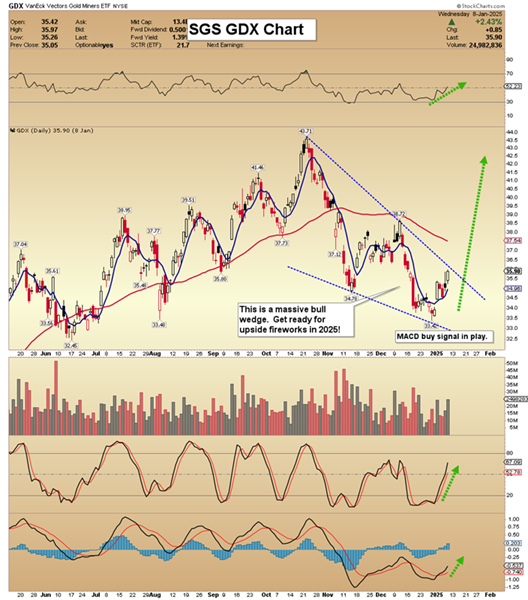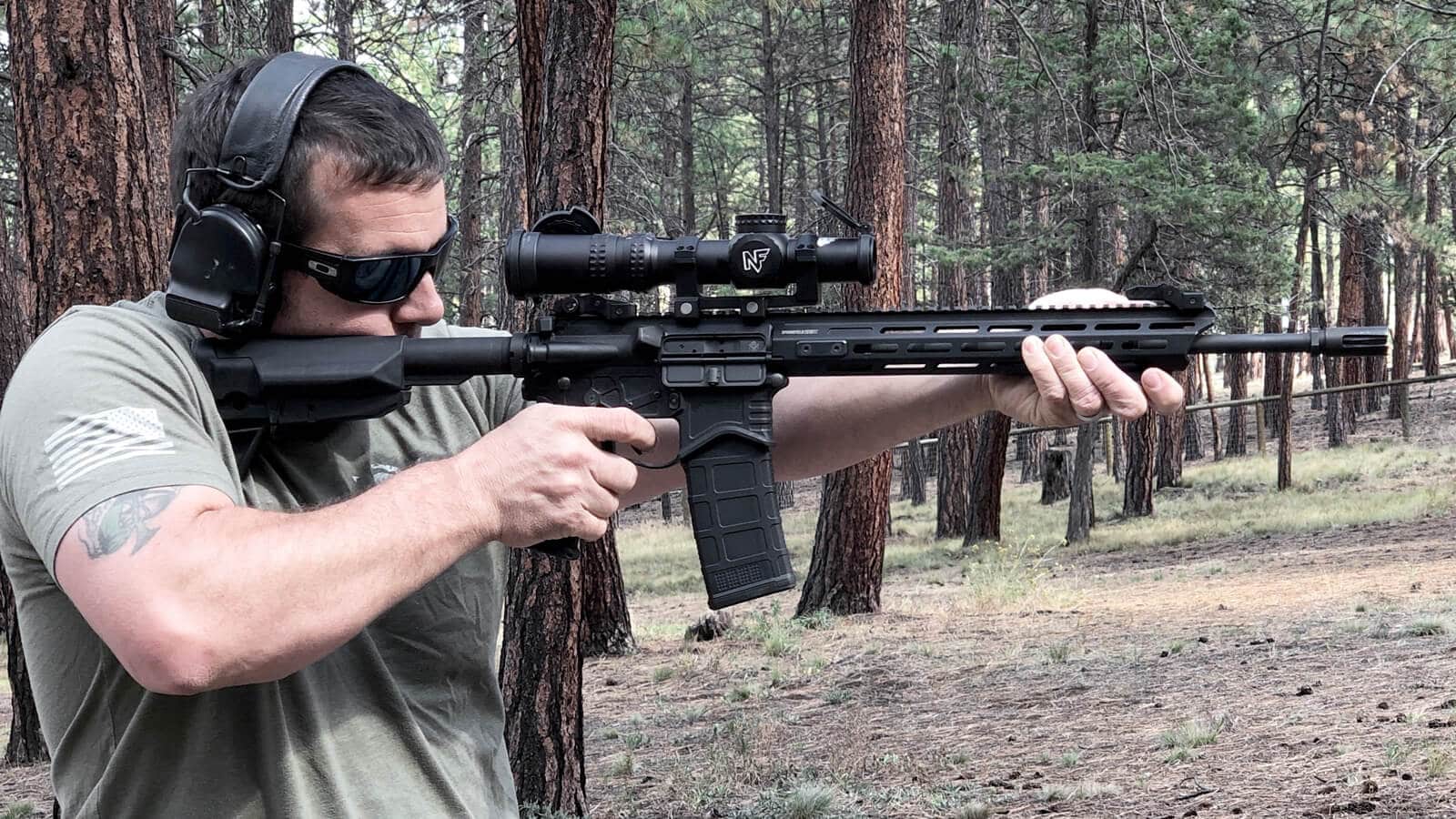SilencerCo introduced a ultra-light 9mm suppressor, the Spectre 9, one of four new silencers at SHOT Show 2024. At the time, the company touted it as half the weight of the popular Omega 9K, but also quieter. While the Spectre 9 does weigh 3.9 ounces compared to the 7.3-ounce Omega 9K, does it live up to the hype? I did some testing to find out.
The Spectre 9 is completely constructed from titanium and is rated for 9mm and subsonic .300 BLK shooting rapid-fire subsonic ammo and slower-fired supersonic ammo. SilencerCo even states it will run on a full-automatic Glock. Sadly, I was unable to see if this was true or not.
Like all SilencerCo suppressors, there are multiple mounting options, including direct thread, a SilencerCo muzzle device that would take an Alpha ASR mount, a piston mount, as well as a 3-lug mount, which is common for MP5 platforms. The suppressor itself ships with a Spectre 9 tool and Spectre 9 piston housing, but not the piston itself, meaning you must purchase the piston separately in order to thread the suppressor onto a handgun. It also does not ship with a direct-thread mount, so if you wanted to thread directly to a 1/2X28 tpi threaded barrel, you’d also need to purchase that item separately.
Admittedly, I found the decision to not ship the necessary attachments perplexing, as it seems SilencerCo wants you to invest in their collection of mounts. But after shooting this can, along with the new Scythe-Ti and swapping between mounts, I have good reason to believe any serious shooter will consider a growing collection of SilencerCo products to be money well spent.
Initial Impressions
I’ve shot SilencerCo’s Omega 9K (the can to which they currently compare the Spectre 9) in the past, but did not put a decibel meter to it. However, I shot both the Omega 9K and the Spectre 9 at the same indoor range and upon firing subsonic 147-grain Remington UMC ammunition through the Spectre 9, I had the RSO come up to me and say, “Man, that thing is quiet for so small of a can,” and I agreed. The Spectre 9 was very quiet, and its weight created a nice balance with shooting through a Walther PDP Pro SD. It felt like it made an already accurate handgun even more accurate.
Nielson Device Or Not?
An explanation of a Nielson Device is in order here. Because of the added weight of a suppressor, some handguns require a Nielson Device (also known as a booster) to cycle properly. If the gun has a tilting barrel like a Glock, you usually need the booster. If it has a moving barrel like a Beretta M9, you probably want the booster. If it has a fixed barrel, you don’t need the booster.
Photo Credit: Aaron Sutton
In some coverage I watched during SHOT 2024, it was suggested that because the Spectre 9 is so light, you shouldn’t need a Nielson Device, meaning you could directly thread this onto even tilting-barrel handguns without a booster for even less weight. I found that to be both the case and not the case.
Despite initial coverage, SilencerCo’s current official position is you want the booster for most handguns. During my first test, I tried mounting the Spectre 9 via direct thread on a Glock G17 with an OEM threaded barrel. I could not even pull back the slide as the Glock’s guide rod made contact with the bottom of the suppressor.
However, using this same method, I was able to run via direct thread on my Walther PDP Pro SD, but the gun was finicky with ammo. Using a Practical Performance guide rod with the 15-pound spring and shooting 147-grain Remington UMC rounds, the gun functioned great until it got dirty, which didn’t take but maybe 30 rounds. It would not cycle any 115-grain ammo. I even switched to the guide rod and lighter spring provided by Walther for suppressed pistols, but that did not work any better. So, next trip, I installed the booster and ran on both the Glock G17 and Walther.
Handgun Results
Firstly, anyone who has shot 9mm handguns suppressed understands there is a bit of voodoo involved. It’s about finding the right ammo, the right guide rod, the right recoil spring—all of which allows the handgun to cycle reliably. It’s even possibly swapping out some internal parts. It’s a balance between the ejection port opening early and thus eating gas versus the gun returning to battery time and again (and of course, cycling reliably).
With the Neilson Device installed (so piston housing plus piston), I ran random magazines of 115-grain Monarch ammo, 115-grain Fiocchi Range Dynamics rounds as well as the 147-grain Remington UMC rounds, which all have a reputation for burning dirty. Running 15-pound springs in both handguns, everything cycled mostly fine, though neither handgun functioned flawlessly. With the 147-grain ammo, the gun might fail to return to battery, but this admittedly started to happen after running several magazines of dirty ammo. Anything lighter would occasionally cause a failure to eject, even at the onset.

To put it succinctly, anyone wishing to run a handgun flawlessly with any suppressor will need to tinker with components from soup to nuts before feeling completely confident with the reliability. The same applies to the Spectre 9 and your setup.
However, when I put the Walther in the hands of a couple friends shooting the 147-grain ammo, they described shooting the Spectre 9 as “cheat mode.” With the balance, generally smooth cycling and sights returning to target quickly, the gun just shot better.
Rifle Results
I tested the Spectre 9 via direct thread on an Aero Precision Atlas S-One .300 BLK AR-15 with a 10-inch barrel shooting 220-grain Sierra MatchKing ammo and also through a Century AP5 pistol via the three-lug mounting system shooting 147 grain Remington UMC ammo, which are both subsonic rounds. Through multiple magazines, both rifles cycled flawlessly. I also tested some supersonic rounds through both, with zero cycling or feeding issues.
I don’t think it makes a whole lot of sense to talk about accuracy in terms of a rifle with a suppressor installed, as the rifle will either shoot more accurate due to barrel harmonics, or it will shoot the same as before. It will vary from platform to platform, and from barrel to barrel. Yes, the point of impact will change due to a change in velocity and, again, barrel harmonics, but it will not shoot less accurately. If it does, the decrease in accuracy is the result of a bad threading job versus a factory-threaded barrel or a loose brake or mounting system, or perhaps even a baffle strike.
But the rifle results bring me to the most brag-worthy topic…
Decibel Reduction
This can is very quiet, with a capital S for “Shhh.” For testing decibels, I purchased an inexpensive sound meter that will provide some context for how every sound registered, as well as generally accepted decibel levels.
Comparison dB Levels
Soft whisper: 30 dB
Rainfall: 50 dB
Normal-volume conversation: 60 dB
BB gun: 97 dB
Shouting: 110 dB
Unsuppressed .22LR: 140 dB
Range Measurements
Loading metal magazine: 82 dB
Spectre 9 on an AP5 (MP5 platform) with 147-grain Remington UMC ammo: 86.5 dB
Spectre 9 on a 300BLK Aero Precision 10-inch AR with 220-grain Sierra MatchKing ammo: 87.8 dB
Spectre 9 on a Walther PDP Pro SD pistol with 147-grain Remington UMC rounds: 87.1 dB
I set the decibel meter to register maximum decibel rating and during testing, I moved the firearms forward and back on the bench, within inches of the meter, to test every sound signature from muzzle to receiver. At one point in test, moving the gun atop a metal barrel registered more noise than any shot.
Muzzle velocities for the handguns average 1,025 fps, while the .300 BLK setup averaged 995 and the AP5, 1,011 fps.
Conclusion
This is a fun, lightweight, durable, and very hush-hush suppressor. One interviewer during SHOT described it as “almost like putting an empty roll of toilet paper on your gun,” and while that reference does make sense in terms of weight and size, this suppressor and toilets—or anything that goes in toilets—are very much not synonymous. Only downside: You can’t shoot 300 BLK supersonic ammunition in a fully-automatic rifle with this suppressor, which is really unfortunate for us folks who have an extra minimum $15,000 just lying around.
SilencerCo Spectre 9 Specifications:
- Caliber Compatibility: 9mm and 300BLK subsonic
- Weight: 3.9 ounces
- Length: 4.76 inches
- Diameter: 1.37 inches
- Materials: Ti Grade 5 and Grade 9
- Muzzle Average: 9 mm: 132.7 dB; .300 BLK Subsonic: 133.3 dB
- Ships With: Spectre 9 tool, Spectre 9 piston housing
- MSRP: $879
Read the full article here












Leave a Reply